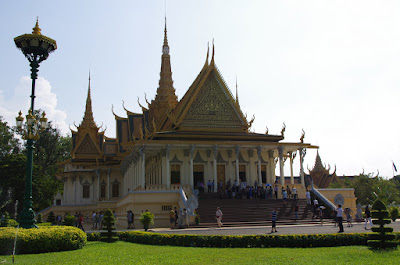I was greeted at the airport in the morning by a Bunong student who is from Sen Monorom and has worked for the past few years with the project coordinator there, but is now attending university here in Phnom Penh. (This is what I'll be doing for the next month, by the way! http://www.globalteer.org/volunteer-projects.aspx?project=cambodia-bunong-hill-tribe) He was kind enough to take me around to the touristy sites in the city all afternoon.
We began at the beautiful Buddhist temple of Wat Phnom...
"Phnom" translates to "hill" in Khmer. Legend has it that long ago Lady Penh, a wealthy widow, discovered a hollow tree in the Mekong River. Inside, she found four bronze statues of the Buddha. Interpreting this as a sign that the Buddha was searching for a new home, she created a small hill and on top of it a temple in which she housed the statues. Pilgrims came to see the temple, and ultimately the city of Phnom Penh, "the hill of the Lady Penh," sprang up around it. Wat Phnom, or "hill temple," is now over six centuries old.
Adjoining the temple is a small museum, the most interesting features of which were dioramas depicting Cambodia's history from the building of the Angkor temples up through the Khmer Rouge era.
If you don't know much about the genocide under the Khmer Rouge (this directed most at readers around my age), you should probably go read about it on Wikipedia at the least. I certainly didn't hear much about it in any of my history classes...
And it, like so many other pieces of history we prefer to forget, is worth making an effort to remember. Tomorrow I will visit the "Killing Fields"at Choeung Ek and also the S21 prison, now a museum. Preparing to be rather overwhelmed.
 |
| Photos I took the next day (we have no respect for chronology here). |
On a lighter note, I visited some fancy palaces!
 |
| That's a complete model of Angkor Wat, to the right of the monk. |
The Royal Palace, a complex of buildings, was the abode of King Ponhea Yat, who ruled from 1396-1463. It was rebuilt to its present state by King Nerodom in 1886 when he moved the capital back to Phnom Penh from Oudong.
Outside the palace, I got my first taste of Cambodian street food: juice squeezed directly from sugar cane, served on ice. Delicious, and see how all-natural it is?
 |
| It must thus be healthy, right? |










